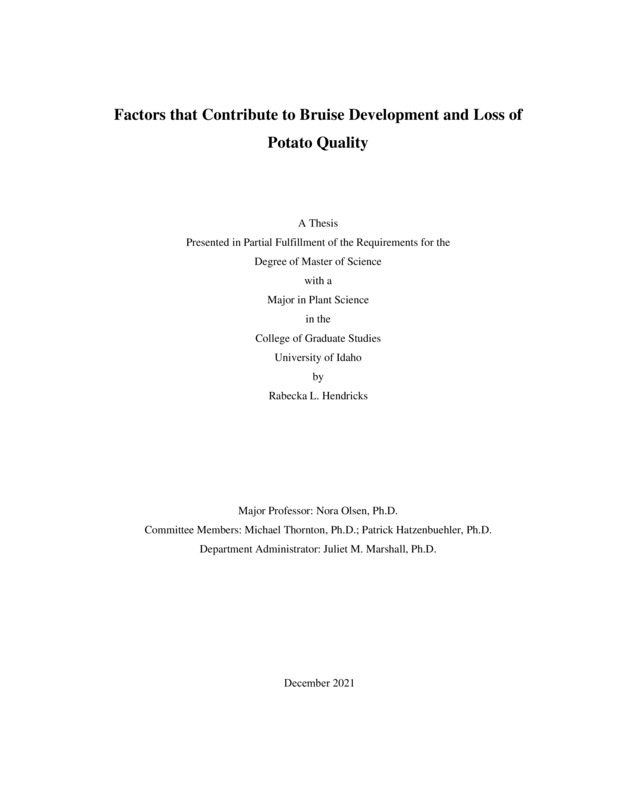Factors that Contribute to Bruise Development and Loss of Potato Quality
Hendricks, Rabecka Lynn. (2021-12). Factors that Contribute to Bruise Development and Loss of Potato Quality. Theses and Dissertations Collection, University of Idaho Library Digital Collections. https://www.lib.uidaho.edu/digital/etd/items/hendricks_idaho_0089n_12196.html
- Title:
- Factors that Contribute to Bruise Development and Loss of Potato Quality
- Author:
- Hendricks, Rabecka Lynn
- ORCID:
- 0000-0002-9583-3894
- Date:
- 2021-12
- Keywords:
- blackspot bruise bruise development bruise susceptibility internal damage quality shatter bruise
- Program:
- Plant, Soil and Entomological Sciences
- Subject Category:
- Plant sciences
- Abstract:
-
Potatoes are extensively handled in the post-harvest chain from harvest in the field until reaching the ultimate consumer. This potato journey includes harvesting, handling in and out of storage, moving through packing sheds or processing facilities, being transported between locations, and finally reaching the consumer. Each time potatoes are handled, the potential for physical damage is heightened, which can result in blackspot and shatter bruises and lower quality. The overall goal of this research was to determine factors that contribute to bruise development and susceptibility and loss of potato quality within the post-harvest chain. To accomplish this goal, four major objectives were conducted in this project. The first objective was to determine how time in storage contributes to bruise development and susceptibility. The second objective was to evaluate the progression of bruise development within 24 hours and if fresh bruises identified up to five hours after impact are a reliable indicator of total bruise development commonly evaluated 24 hours post impact. The third objective was to examine bruise susceptibility of six cultivars impacted by a standard weight at three different drop heights. The final objective was to examine the bruise potential in packaged potatoes at a fresh pack facility. Bruise development and susceptibility were determined using a 100 g weight to deliver uniform impacts on tubers. Evaluations for blackspot and shatter bruise variables were carried out on common russet cultivars including Russet Burbank, Russet Norkotah, Ranger Russet, Clearwater Russet, Teton Russet, Dakota Russet and Umatilla Russet between the first three objectives. Objective four utilized an impact recording device that measured peak accelerations experienced when packaged potatoes were dropped from various heights and onto different impact surfaces. Key outcomes from this project are as follows. When tubers were bruised at harvest, the incidence of blackspot bruise increased within the first month of storage but afterwards remained at similar levels for the remaining months examined (eight months). Physical impacts at harvest resulting in shatter bruise showed no further development in storage. Potatoes physically impacted once removed from storage, showed a slight increase in blackspot bruise susceptibility over time, whereas shatter bruise susceptibility decreased the longer potatoes were held in storage. Looking at susceptibility of a single tuber, the risk of shatter bruise was greater near the bud end of the tuber, whereas the risk of blackspot bruise increased with proximity to the stem end. The shoulder location of a russet potato had higher bruise susceptibility compared to the flat surface indicating curvature of the tuber has a role in bruise susceptibility. The development of a bruise was evident within just a few hours of a 24-hour period after a physical impact occurred. The bruise color changed from a pink to brown discoloration primarily one to three hours after impact, and the incidence of pink discoloration declined rapidly after that time. Over 70% of the total blackspot bruise incidence was observed after four hours depending upon force of impact and cultivar. The majority (70%) of total bruise depth was developed five hours after impact. Significant differences in blackspot and shatter bruise susceptibility were seen between cultivars at different impact heights. Clearwater Russet and Dakota Russet had the highest blackspot bruise incidence compared to other cultivars examined. Teton Russet had the lowest blackspot bruise incidence, severity rating and depth examined between the cultivars but had the highest shatter bruise incidence. Dakota Russet had low susceptibility to shatter bruise at all impact heights examined. When boxed potatoes were dropped on to concrete or a plastic slip, the potatoes on the bottom of the box would have the highest risk of damage. The risk for damage was lower for potatoes in the top or middle of the box. When drop heights were lowered, or when cushioning material was added to hard impact surfaces (wooden pallet), the risk for impact damage was decreased throughout the box. When palletizing boxed potatoes, the risk of bruise decreased after the first layer was stacked on the pallet. The risk of high peak accelerations (over 100 g) was not seen in the dropped or stationary bales for any of the drop heights examined. Increased cushion for the bottom stack of potatoes during palletization in fresh pack facilities could lower the risk of bruise. Innovation of cushioned plastic slips could provide an economical and efficient alternative to wooden pallets. The overall project provided information for the industry to make decisions about how to manage for bruise at harvest, in storage, unloading, and in fresh pack and processing facilities.
- Description:
- masters, M.S., Plant, Soil and Entomological Sciences -- University of Idaho - College of Graduate Studies, 2021-12
- Major Professor:
- Olsen, Nora
- Committee:
- Thornton, Michael; Hatzenbuehler, Patrick
- Defense Date:
- 2021-12
- Identifier:
- Hendricks_idaho_0089N_12196
- Type:
- Text
- Format Original:
- Format:
- application/pdf
- Rights:
- In Copyright - Educational Use Permitted. For more information, please contact University of Idaho Library Special Collections and Archives Department at libspec@uidaho.edu.
- Standardized Rights:
- http://rightsstatements.org/vocab/InC-EDU/1.0/

